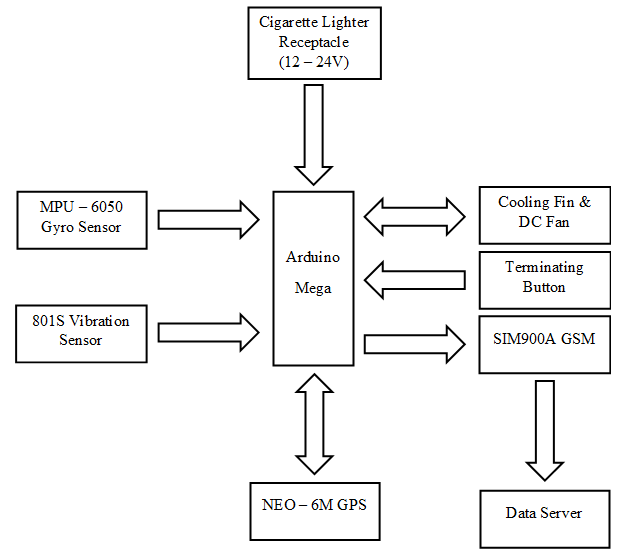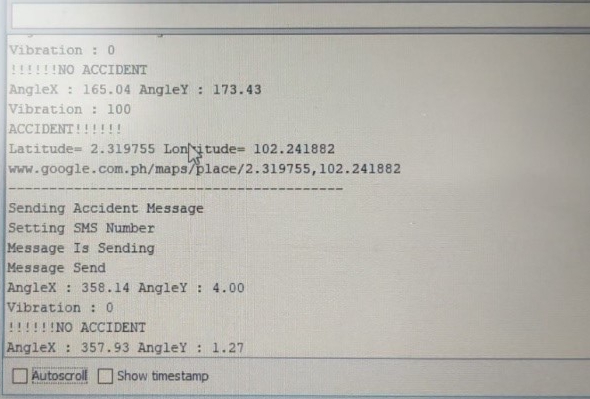VEHICLE ACCIDENT DETECTION SYSTEM USING INTERNET OF THINGS (VADS – IoT)
Date: January 05, 2022 |Published by: MIU | Category: Blogs
Abstract
This paper aims to improve the response time of the emergency response department to be informed on vehicle accidents in Malaysia. The primary impact of this work was to reduce the waiting period for accident victims to receive medical assistance and be rescued from a catastrophic vehicle accident. The conceptual idea of achieving this was by accommodating sensors and a microcontroller in a vehicle to compute the displacement of the vehicle. The system was developed using a vibration sensor to determine the collision impact of an accident and a gyro sensor to determine the x-y displacement of the vehicle. When an accident occurs, the instantaneous coordinates of the vehicle will be captured using a GPS module and transmitted to the emergency response department via a GSM module. The coordinates are visualized on a registered mobile phone at the emergency response department and mirrored to a desktop’s Pushbullet application. With that, necessary emergency response units can be deployed to the accident location. The outcome of this project utilizes a gyro sensor to monitor angles between 45° – 315° and a vibration sensor at collision impact frequency of more than or equal to 90 Hz. The prototype can be a viable system to be incorporated by vehicle manufacturers in Malaysia to improve the safety features of a vehicle and ensure a better reliability of vehicle accident detection and reporting system.
Introduction
The amount of road accidents in Malaysia have been increasing at an alarming rate. In 2018, the Ministry of Transport (MoT) Malaysia reported a total of 548,-598 road accidents; where 6,-284 of them were casualties that resulted in death [1]. The life and death status of a victim is decided by the response time of the emergency response department (ERD) which varies depending on the speed the accident information is received by the ERD [2]. The importance of having a faster response time when an accident has occurred is crucial to accident victims. Extensive analysis has shown that by decreasing the accident response time by a minute, it would help increase the chances of saving an individual of up to 6% [3]. Characteristically, the response time of an accident is associated with the location and severity of an accident coupled with the congestion caused around the location of accident. During minimal traffic congestion, the occurrence of an accident would increase the response time for the ERD to be notified about the accident, sometimes up to 24 hours [2].
The proposed Vehicle Accident Detection System using Internet of Things (VADS – IoT) was introduced and developed to reduce the time taken for an accident to be reported to the ERD. The incorporation of IoT extends the network connectivity between different systems with minimal human intervention [4]. The communication between the on board sensors and Global System for Mobile Communications (GSM) module available in the vehicle’s central processing box (CPB) forecast significant improvements of accident data transmitted towards the ERD, thus ensuring the system is reliable, efficient and effective [5]–[10].
Research Method
Block Diagram of VADS – IoT
The overall design of the VADS – IoT is shown in Fig. 1. The power for the Arduino Mega microcontroller was obtained from a vehicle’s cigarette lighter receptacle (CLR). A vibration and gyro sensor measured the vehicle’s collision impact frequency and x-y displacement of the vehicle, respectively. The communication peripherals were a GPS and GSM module to capture instantaneous coordinates of the vehicle and transmit it towards the ERD, respectively. A terminating button was used to terminate the data transmission. All these electronic components were placed inside a CPB along with its cooling system. A cooling fin was mounted on the top of the current and voltage regulator of the Arduino Mega microcontroller to evenly dissipate heat produced by the microcontroller during operation.

Fig 1. Block diagram of the VADS – IoT
Results and Discussion
VADS – IoT System Responses to An Accident Environment
Fig. 2 shows the outcome of the designed VADS – IoT. A Maxis carrier SIM card was placed inside the GSM module for data transmission of instantaneous accident coordinates. Silicone sealant was used to fill any gaps/holes once the DC barrel connector was fitted through the CPB.

Fig 2. Final VADS - IoT prototype
The simulation of accident was done at a construction area which had uneven, bumpy and untarred roads. An accident was simulated by driving fast and braking at a sharp turn radius which resulted in the VADS to detect an ‘accident’, thus providing the instantaneous coordinates of the vehicle. In 20 seconds, those coordinates were visualized on a registered mobile phone. Fig. 3 shows the pseudocode of the accident information on the Arduino IDE serial monitor. When the visualized information was mirrored to the desktop using the Pushbullet application, the string formatted Google Maps coordinates was clicked and the Google Maps link web page was displayed which showed the location of the extracted coordinates.
The minimum conditions for the VADS to extract the accident coordinates was determined by two components; gyro and vibration sensor. The gyro sensor had angles between 45° - 315° while the vibration sensor had threshold collision impact frequency of more than or equal to 90 Hz. The ‘AND’ between these two pseudocodes caused the VADS to detect an occurrence of an accident. Upon completion of the testing, the prototype was fully functioning with satisfying all the defined objectives. The VADS – IoT was ensured to have fulfilled the requirement of being a time saving VARS.

Fig 3. Instantaneous accident information on Arduino IDE
Conclusion
This work has developed a VADS – IoT to improve the response time of the ERD by answering the justified initial objectives. It was established that when the pseudocode of the vibration and gyro sensors were met, the VADS extracted the instantaneous coordinates of the vehicle and transmitted it towards the ERD. This design is viable in Malaysia as it can be equipped in upcoming vehicle manufacturing companies to help save more life with minimal amount of human intervention. The ERD would also be a great beneficial of responding to emergency accident situation more accurately and effectively without any wastage of additional time.
This work has opened several questions that needs further investigations and improvements. Future prospects include in transmitting the accident data directly towards a web server. This would abstain the use of a mobile phone at the ERD and further improve the speed of the accident data transmission. GPS and GSM modules can also be removed from the system. Instead, the VADS can be directly interconnected with the vehicle’s GSM and GPS module, reducing the overall cost and simplifying the development of the system.
References
[1] Ministry Of Transport Malaysia, “Transport Statistics Malaysia 2018,” 2018.
[2] M. Vijayan, C. I. Kaplas, and S. Ganguly, “Accident Detection and Response System with Error Avoidance,” Int. J. Appl. Eng. Res., vol. 12, no. 13, pp. 3562–3565, 2017.
[3] A. Khan, F. Bibi, M. Dilshad, S. Ahmed, Z. Ullah, and H. Ali, “Accident Detection and Smart Rescue System using Android Smartphone with Real-Time Location Tracking,” Int. J. Adv. Comput. Sci. Appl., vol. 9, no. 6, pp. 341–355, 2018.
[4] M. Marimuthu, S. Nivetha, and K. Sirushti, “Accident Detection and Reporting System using Internet of Things,” Res. J. Sci. Eng. Syst., vol. 3, no. 2, pp. 121–129, 2018.
[5] M. S. Janakiramkumaar, A. Manavalan, S. Rajarajan, and R. Premalatha, “Accident Detection And Vehicle Safety using Zigbee,” Int. Res. J. Eng. Technol., vol. 3, no. 5, pp. 947–950, 2018.
[6] B. Kumar, P. Kumar, S. Kumar, S. R. Dhande, and S. D. Kakde, “Automatic Vehicle Accident Detection and Rescue System,” vol. 5, no. 05, pp. 724–726, 2017.
[7] E. K. Priya, P. Manju, V. Mythra, and S. Umamaheswari, “IoT Based Vehicle Tracking and Accident Detection System,” Int. J. Innov. Res. Comput. Commun. Eng., vol. 5, no. 3, pp. 4424–4430, 2017, doi: 10.15680/IJIRCCE.2017.
[8] S. N. R. G, K. Swaroopa, and M. P. Yogitha, “IOT Based Vehicle Tracking and Accident Detection System,” Int. J. Innov. Res. Sci. Eng. Technol., vol. 7, no. 6, pp. 381–386, 2018.
[9] C. Prabha, R. Sunitha, and R. Anitha, “Automatic Vehicle Accident Detection and Messaging System using GSM and GPS Modem,” Int. J. Innov. Res. Electr. Electron. Instrum. Eng., vol. 3, no. 7, pp. 10723–10727, 2014, doi: 10.15662/ijareeie.2014.0307062.
[10] V. Goud and V. Padmaja, “Vehicle Accident Automatic Detection and Remote Alarm Device,” Int. J. Reconfigurable Embed. Syst., vol. 1, no. 2, pp. 49–54, Jul. 2012, doi: 10.11591/ijres.v1i2.493.
[11] A. K. A, V. Jaganivasan, T. Sathish, and S. Mohanram, “Accident Detection And Alerting System using GPS & GSM,” Int. J. Pure Appl. Math., vol. 119, no. 15, pp. 885–891, 2018.
[12] A. Rajkiran and M. Anusha, “Intelligent Automatic Vehicle Accident Detection System Using Wireless Communication,” Int. J. Res. Stud. Sci. Eng. Technol., vol. 1, no. 8, pp. 98–101, 2014.
[13] M. S. Tayde and A. P. Phatale, “Implementation Of Intelligent Automatic Vehicle Accident Prevention and Detection System,” Int. J. Ind. Electron. Electr. Eng., vol. 4, no. 8, pp. 92–95, 2016.
[14] S. B. Kumar, “Proof collection from car black box using smart phone for accident detection Divyashree K 1 , Likhithesh M D 2 , Arpitha M 3 , MadanRaj K S 4 , Raghu S 5 , Vinay,” vol. 5, no. May 2015, pp. 16–20, 2015.
[15] C. Thompson, J. White, B. Dougherty, A. Albright, and D. C. Schmidt, “Using Smartphones to Detect Car Accidents and Provide Situational Awareness to Emergency Responders,” in Lecture Notes of the Institute for Computer Sciences, Social-Informatics and Telecommunications Engineering, vol. 48 LNICST, 2010, pp. 29–42.
[16] K. Sawant, I. Bhole, P. Kokane, P. Doiphode, and P. Y. Thorat, “Accident Alert and Vehicle Tracking System,” Int. J. Innov. Res. Comput. Commun. Eng., vol. 4, no. 5, pp. 8619–8623, 2016, doi: 10.15680/IJIRCCE.2016.
[17] M. Maksimović, V. Vujović, N. Davidović, V. Milošević, and B. Perišić, “Raspberry Pi as Internet of Things hardware : Performances and Constraints,” in Design Issues, 2014, vol. 3, no. JUNE, p. 8.
[18] C. Morley, M. Unwin, G. M. Peterson, J. Stankovich, and L. Kinsman, “Emergency department crowding: A systematic review of causes, consequences and solutions,” PLoS One, vol. 13, no. 8, p. e0203316, Aug. 2018, doi: 10.1371/journal.pone.0203316.
